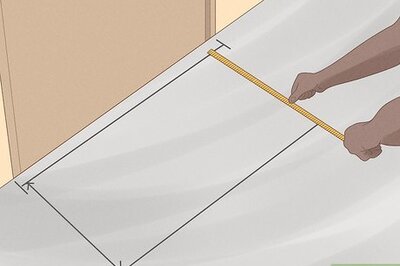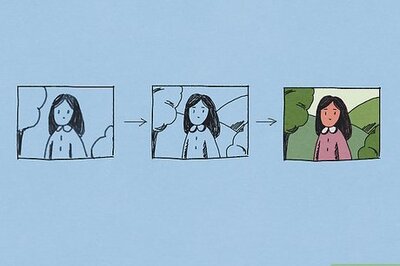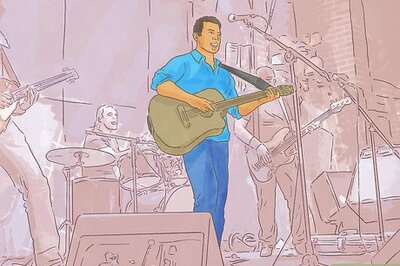
views
Slipping Inside the Jab
Start with both hands up and your weight centered. To slip a punch inside the jab, you should position your hands near your face and place your weight centered squarely over both legs. This will put you in the perfect position to rotate your body and slip a punch. Keep your feet shoulder-width apart with your less dominant foot slightly forward. If you are right-handed, your left foot should be slightly forward. This will help give you more balance when you want to slip a punch or throw one of your own. This defensive position is very important, since it’s often difficult to retaliate when you are so close to your opponent.
Rotate your body counterclockwise. Lean slightly to the left and transfer a bit of your body weight to rest more fully on your left leg. As you lean, rotate your body slightly in a counterclockwise direction. This will help you keep your guard up as you move to slip the punch. You should pivot your back foot in a counterclockwise motion that mimics your body’s movement. Raise up slightly on the ball of your right/back foot and turn the foot in coordination with the rest of your body.
Raise your rear hand a bit. Your rear hand should be your more dominant hand. This movement will put you in the perfect position to protect yourself if your opponent decides to throw a left hook. The raised rear hand will be able to block any punches that you aren’t able to slip by rotating out of the way. At this point, you’ll be able to step in with your leading foot and throw a jab of your own. Depending on the positioning of your opponent, you’ll most likely throw a jab with your dominant hand.
Make your body compact by slipping inward. If your opponent is throwing a left jab, you should pull your right shoulder toward your left knee rather than just ducking the punch. Bend your knees slightly, turn your hips slightly counterclockwise, pull your right shoulder down in the direction of your left knee, and turn your head down – all in the same motion. This will make your body more compact and give you more control over your movements. Be sure to keep your eye on your opponent and your chin tucked behind your shoulder during this entire move. This move will help you keep a strong center of gravity, and make it easier for you to come back up after you slip the punch.
Slipping Outside the Jab
Stand with your feet shoulder-width apart and your hands raised. Keep your feet slightly apart, with your less dominant foot (your left foot, if you are right-handed) positioned somewhat in front of the more dominant foot (your right foot, if you are right-handed). Raise your hands near your face for a good defensive stance. This will put you in the right starting position to slip a punch outside of the jab.
Rotate your body clockwise. As your opponent pumps their jab, rotate your body clockwise a bit and lean slightly to the right. In the process, you should shift a portion of your weight to your rear leg. If you are right-handed, your rear leg should be your right leg. These movements should be quite small – you don’t want to move too much out of the way, or you may throw yourself off balance. You’ll need to pivot both of your feet in the same clockwise direction that you rotated your hips.
Step in while pumping your own jab. After you’ve pivoted away, you can move a bit closer to your opponent by stepping in toward them while you are throwing a punch. If you throw a punch with your dominant hand (right, for example), your opposite leg (left) should come forward. This will keep your head outside of your opponent’s jab reach. At this point, you’ve fully slipped your opponent’s punch and you should be able to put out a crossover jab over their arm, or an uppercut from below to their body. Choose which arm to jab or uppercut with based on your opponent’s body positioning. If you have a clear crossover shot, you will likely jab with the same arm your opponent did, as it will “cross over” their arm. If you have an opportunity to give your opponent an uppercut jab, use whichever arm is the closest or would be coming from the most effective angle. An inherent advantage of slipping is that one of your opponent’s hands is next to your head. That is one less hand they can use to defend themselves and a hand that must be pulled back before your opponent can go anywhere.
Avoid moving your head back to its original position. This amateur mistake is very predictable and can lead to a quick knockout. Instead, adjust your feet slightly to match where your head is or bob and weave into a new position – anywhere but where your head started will do. Becoming predictable and returning to the same position are great ways to help your opponent predict your moves.
Being Quick and Agile
Practice quickness and agility drills. Try using a ladder to complete agility drills. Start by placing a ladder on the ground and hopping on one leg through each rung until you reach the end. Turn around and repeat the process with the other leg. Once you master these steps, you can try alternating legs as you move across the ladder. You can also try various sprinting activities, as these can also increase your agility in the boxing ring. Sprinting involves running as fast as you can for shorter periods of time. Try varying long-distance running with sprints. Long-distance runs will help improve your endurance, and they'll help you recover faster during a boxing match. Sprints will help strengthen your legs and footwork, and they'll help prepare you for the chaos of a fight. Jumping rope can help improve your balance, which is essential for defense. You might also want to try follow-the-leader drills where you follow a trainer and mimic their actions. This helps you hone your observation skills and improve your reaction time.
Move your head from side to side. This is a classic boxing move for slipping a punch and keeping your opponent on their toes. If you weave your head back and forth within the jab range, it makes your opponent guess where your head will be when they try to punch you. It’s always harder to hit a moving target. Make sure that your head movements are somewhat irregular, not just back and forth to a steady rhythm. Otherwise, this is just as predictable as keeping your head still.
Keep a rhythmic stance. One of the most exciting aspects of boxing is that it is not predictable. You never know when a punch will come or just what your opponent is going to do next. In order to stay on top of your game, you need to maintain an easy, rhythmic stance – bounce your weight back and forth between your two feet. Keep your hands up by your face in the defensive position. Jump around a bit. These kinds of movements help you stay in the moment, focus on what your opponent is doing, and slip punches in the moment when you see them coming.
Stay alert. One of the most important aspects of a quick reaction time is remaining alert and present. Stay in the moment and don’t let your mind wander. Watch your opponent closely so that you are ready to react and slip the punch as soon as you see it coming. Don’t take your eyes off your opponent even for a moment. This could give them the opportunity to catch you off your guard.
Preparing for a Fight
Warm your body up before any fight. A crucial part of being ready to slip a punch in a fight is having an alert mind and a ready body. It’s a good idea to get your body warmed up by stretching and jumping a little. This will help you be ready and awake in order to slip punches when you see them coming your way. Some great stretches to perform before you jump in the boxing ring are the standing toe-up Achilles stretch, assisted reverse chest stretch, and rotating stomach stretch. Try incorporating plyometric stretches before a match, like push-ups and lunges. Always warm up your neck to prevent stiffness. This will help you move more quickly when you need to slip a punch. To warm up your neck, try loosening up your jaw and rolling your head around on your neck. Roll your head forward, then all the way around to the back in a half-circle. Then rotate it the other way. Do this for several minutes.
Learn your own default moves. Learning how you naturally react in boxing situations is a great way to avoid becoming predictable to your opponent. Avoid predictability while slipping a punch by learning some common moves: Throw a jab a little left of center to catch your opponent off-guard. Throw or feint one jab, then throw another quick one in the hopes that your opponent won't recover quickly enough.
Observe your opponent. Often, having quick reflexes is not enough. During a fight, you can become punch drunk or tired and lose your faculties. Because of this, it’s helpful to study your opponent in the beginning of the fight and learn their tells. Watching your opponent can help you learn when they are going to throw a punch and what kind of punch it will be. Don't make too many assumptions about your opponent’s behavior. There is a chance that they are trying to get you into habits that will set you up for a knockout punch.




















Comments
0 comment